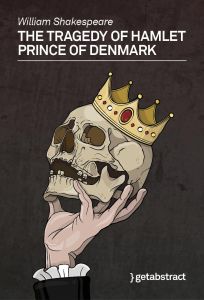
The Tragedy of Hamlet
Prince of Denmark
- Tragedy
- Elizabethan Era
What It’s About
The Tragedy of a Well-Examined Life
The 16th century and its religious wars; colonial conquests; and economic, technological and military advances brought an end to the certainties of the Middle Ages and the naive hopes of the Renaissance. When Shakespeare wrote The Tragedy of Hamlet, Prince of Denmark at the dawn of a new century, Tudor England was enjoying a brief period of stability and comfort under an aged Queen Elizabeth I after a century of turmoil, intrigue and existential wars. Shakespeare’s prince is a man of comfort and privilege, but obligations derived from past events for which he wasn’t responsible torment him. While passion may bring others to act before thinking of the consequences, he is too thoughtful to act foolishly. Like many of Shakespeare’s contemporaries who knew the compromises of Tudor England and its falsity and opportunism, Hamlet also knows that a principled stand may be worse. The late Tudor period is a time for cunning, not idealism. Still, Hamlet is troubled because he knows that inaction isn’t just, and the play follows him as he tries to reason his way to a better answer – suffering madness, cynicism, duplicity and betrayal in the process. The final disaster presages the horror of the English Civil War only four decades into the future.
Summary
About the Author
It isn’t an overstatement to say that William Shakespeare is the most famous and important playwright of world literature. He wrote a total of 36 plays and 154 sonnets. He is presumed to have been born on April 23, 1564 as the son of glove maker and mayor John Shakespeare. His mother, Mary Arden, descended from a wealthy family of the Roman Catholic landed gentry. In 1582, Shakespeare married Anne Hathaway, eight years his senior and daughter of a landowner, with whom he had three children: Susanna and the twins Hamnet and Judith. Around 1590, he moved to London, where he quickly made a name for himself as an actor and playwright. Starting in 1594, he was a member of the theater troupe Lord Chamberlain’s Men, later named King’s Men. In 1599, a partnership of members built the Globe Theater, which he lovingly referred to as “my wooden O,” the circular form of which is modeled after a Greek amphitheater. Queen Elizabeth I died in 1603, King James took over the throne. Starting in 1608, Shakespeare also became involved in the Blackfriars Theater. In 1597, he bought a property in Stratford and most likely retired from theater life after 1613. He died on April 23, 1616. Shakespeare’s life was only sparsely documented, which is why his biography is so fragmented. Time and again, speculations arise to the effect that someone else wrote his works – or at least parts of them. They have been attributed to the philosopher and statesman Francis Bacon, the playwright Christopher Marlowe, and even Queen Elisabeth I herself. However, no one has been able to produce evidence for such hypotheses. Today, the majority of scholars believe that Shakespeare is the authentic and sole author of his literary work.








Comment on this summary